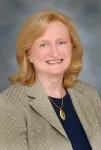(Press-News.org) The Colorado River’s future may be a little brighter than expected, according to a new modeling study from CIRES researchers. Warming temperatures, which deplete water in the river, have raised doubts the Colorado River could recover from a multi-decade drought. The new study fully accounts for both rising temperatures and precipitation in the Colorado’s headwaters, and finds precipitation, not temperature, will likely continue to dictate the flow of the river for the next 25 years.
Precipitation falling in the river’s headwaters region is likely to be more abundant than during the prior two decades. The work, published today in the Journal of Climate, comes as policymakers, water managers, states, and tribes look for answers on how to govern the Colorado River’s flows beyond 2025.
“It’s a sort of nuanced message,” said Balaji Rajagopalan, CIRES Fellow and co-author of the study. “Yes, the temperature is warming, but that’s not the full story—you add precipitation and you get a fuller picture.”
CIRES affiliate Martin Hoerling and Fellow Balaji Rajagopalan worked with colleagues from several other institutions to analyze data from a suite of models, including climate projections from the Intergovernmental Panel on Climate Change (IPCC). They determined that while warming temperatures have depleted Colorado River flows in recent decades, precipitation variations have mostly explained the swings between wet and dry periods since 1895.
Because precipitation has explained the vast majority of the ups and downs of the Colorado River’s flows in the last century, climate models forecasting a 70 percent chance of increased precipitation offer hope that the river’s near-term future is not necessarily drier than the last two decades.
“We find it is more likely than not that Lee Ferry flows will be greater during 2026-2050 than since 2000 as a consequence of a more favorable precipitation cycle,” said Martin Hoerling, the paper’s lead author. “This will compensate the negative effects of more warming in the near term.”
The authors analyzed flow records at Lee’s Ferry, the dividing point of the river’s upper and lower basins, dating back to 1895. They confirmed natural changes in precipitation have ebbed and flowed over the century, dictating extreme wet and dry periods for the river, when flows exceeded 15 million acre-feet or dropped well below that key figure. For example, the current megadrought that began in 2000 has resulted mostly from low precipitation which left the river at about 12.5 million acre-feet reducing it to dry sandy river beds in Mexico.
Looking ahead, the team used climate models, including the latest climate projections from the IPCC, to predict the river’s flow 25 years into the future. Most of the water that feeds the Colorado River begins as snow in the region's headwaters—mountains above 10,000 feet in Colorado and Wyoming. The area represents a small slice of the basin’s geography, about 15 percent, but generates 85 percent of the water that flows through seven states. So precipitation in this “upper basin” is integral to flows in the entire river system. And the team found it is likely to increase, partially offsetting further declines linked to rising temperatures.
While an increase in precipitation is likely, the study finds a low probability that precipitation might not recover and could decline even further. If this happens, ongoing warming would further reduce water resources, resulting in even lower flows at Lee’s Ferry than those that have led to today’s crisis.
“There’s roughly a 4 percent chance that Lee Ferry flows could decline another 20 percent in the next quarter century compared to the last 20 years,” Hoerling said. “So, policymakers who must especially take into account risks of extended dry times, might consider this non-zero threat that the river could yield only 10 million acre-feet a year during 2025-2050.”
As the deadline slowly approaches to determine the next set of guidelines that will govern the river for the next 25 years, the new forecast may shed new light on the future
“Decision makers are confronted with a more optimistic vision of the available supply in coming decades than might have generally been foreseen previously,” Hoerling said, “but also confronted with a small, but perhaps unacceptable, risk for historically low flows.”
END
Precipitation may brighten Colorado River’s future
2024-05-01
ELSE PRESS RELEASES FROM THIS DATE:
Identifying risks of human flea infestations in plague-endemic areas of Madagascar
2024-05-01
Madagascar is one of the last places where outbreaks of human bubonic plague still happen regularly.
Fleas carrying the plague bacterium Yersinia pestis can spread the disease through their bites. And while a species commonly known as “the rat flea” has been fingered as the main culprit in plague outbreaks, a species known as “the human flea” may play a secondary role.
As an investigator during plague outbreaks in rural Madagascar, medical entomologist Adelaide Miarinjara knew that many households were teeming with these human fleas. Miarinjara grew up in the ...
Archaea can be picky parasites
2024-05-01
A parasite that not only feeds of its host, but also makes the host change its own metabolism and thus biology. NIOZ microbiologists Su Ding and Joshua Hamm, Nicole Bale, Jaap Damsté and Anja Spang have shown this for the very first time in a specific group of parasitic microbes, so-called DPANN archea. Their study, published in Nature Communications, shows that these archaea are very ‘picky eaters’, which might drive their hosts to change the menu.
Archaea are a distinct group of microbes, similar to bacteria [see box]. The team of NIOZ microbiologists studies the so-called ...
EPA underestimates methane emissions from landfills, urban areas
2024-05-01
The Environmental Protection Agency (EPA) is underestimating methane emissions from landfills, urban areas and U.S. states, according to a new study led by researchers at the Harvard John A. Paulson School of Engineering and Applied Sciences (SEAS).
The researchers combined 2019 satellite observations with an atmospheric transport model to generate a high-resolution map of methane emissions, which was then compared to EPA estimates from the same year. The researchers found:
Methane emissions from landfills are 51% higher compared to EPA estimates
Methane emissions from 95 urban areas are 39% higher than EPA estimates
Methane emissions ...
Feathers, cognition and global consumerism in colonial Amazonia
2024-05-01
Amazonia is the home of the largest variety of birds in the world. In such a unique environment, craft cultures have flourished by translating the beauty and creativity of environmental materials like feathers into stunning pieces of art. “The Material Creativity of Affective Artifacts in the Dutch Colonial World,” a new article in Current Anthropology by Stefan Hanß of the University of Manchester, examines artisanal featherwork within the context of early modern colonialism ...
Satellite images of plants’ fluorescence can predict crop yields
2024-05-01
ITHACA, N.Y. – Cornell University researchers and collaborators have developed a new framework that allows scientists to predict crop yield without the need for enormous amounts of high-quality data – which is often scarce in developing countries, especially those facing heightened food insecurity and climate risk.
In many parts of the world, crop yields are dropping, largely due to the effects of climate change. According to a recent Cornell study, over the last four decades, for every 1 degree Celsius of warming, net farm income decreased by 66%.
Farmers in developed countries can often rely on big datasets ...
Machine learning tool identifies rare, undiagnosed immune disorders through patients’ electronic health records
2024-05-01
Researchers say a machine learning tool can identify many patients with rare, undiagnosed diseases years earlier, potentially improving outcomes and reducing cost and morbidity. The findings, led by researchers at UCLA Health, are described in Science Translational Medicine.
“Patients who have rare diseases may face prolonged delays in diagnosis and treatment, resulting in unnecessary testing, progressive illness, psychological stresses, and financial burdens,” said Manish Butte, MD, PhD, a UCLA professor in pediatrics, human genetics, and microbiology/immunology who cares for these patients in his clinic at UCLA. “Machine learning and other artificial intelligence ...
MD Anderson researcher Sharon Dent elected to prestigious National Academy of Sciences
2024-05-01
HOUSTON ― Sharon Dent, Ph.D., professor of Epigenetics and Molecular Carcinogenesis at The University of Texas MD Anderson Cancer Center, has been elected to the National Academy of Sciences (NAS). Dent is a global leader in the field of chromatin research whose foundational work has helped define the role of chromatin in cancer growth and development.
Dent is one of 120 members and 24 international members elected this year in recognition of their distinguished and continuing achievements in original research. The NAS, established in 1863 by President Abraham Lincoln, is a private, nonprofit society of distinguished scholars engaged in scientific and engineering research.
With ...
Nonmotor seizures may be missed in children, teens
2024-05-01
EMBARGOED FOR RELEASE UNTIL 4 P.M. ET, WEDNESDAY, MAY 1, 2024
MINNEAPOLIS – Children and teens may experience nonmotor seizures for months or years before being seen in an emergency department for a more obvious seizure that includes convulsions, according to a study published in the May 1, 2024, online issue of Neurology®, the medical journal of the American Academy of Neurology. Even then, the history of nonmotor seizures may not be recognized.
“Early diagnosis of epilepsy is of the utmost importance because epileptic seizures can lead to injury and even death,” said study author Jacqueline French, MD, of NYU Grossman School of Medicine ...
Emergency departments frequently miss signs of epilepsy in children
2024-05-01
A subtle type of seizure goes undetected two thirds of the time in pediatric emergency departments, a new study shows.
The work focuses on “nonmotor” seizures, which cause children to “zone out” and stare into space or fidget. They may also feel sudden changes in emotions, thoughts, or sensations, as opposed to motor seizures, which cause muscles to move in abrupt, jerking motions.
According to the authors, improving recognition of nonmotor seizures may speed up the diagnosis and treatment of epilepsy in children, ...
Unraveling the roles of non-coding DNA explains childhood cancer’s resistance to chemotherapy
2024-05-01
(MEMPHIS, Tenn. – May 01, 2024) St. Jude Children’s Research Hospital scientists have identified specific DNA variants in the non-coding regions of the genome contributing to chemotherapy resistance in acute lymphoblastic leukemia (ALL). The results guided the team to unravel the mechanism behind a previously unknown contributor to therapeutic resistance. The discovery was enabled by combining new technologies to overcome previous limitations in understanding the non-coding genome, which could be adapted to other ...



